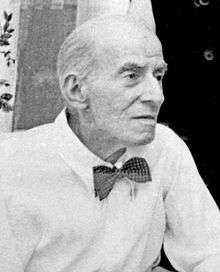Percival David

Sir Percival Victor David Ezekiel David, 2nd Baronet (21 July 1892 – 9 October 1964) was a Bombay-born British financier who is best known as a scholar and collector of Chinese ceramics.[2] He also formed a collection of Chinese stamps and postal history that has been evaluated as one of the greatest ever assembled.
Early life
Percival Victor David Ezekiel David was born in Bombay on 21 July 1892 into a Jewish family in British India that originated in Baghdad. His father, Sir Sassoon David, 1st Baronet, founded the Bank of India.[3]
He was educated in India at Elphinstone College and the University of Bombay, and then at the University of London (D. Lit.).
Personal life
David married in 1912,[4] and Sheila Yorke Hardy was his second wife[5]
He married in 1920, in London, and inherited his father's baronetcy in 1926.
Career
David was a financier and the chairman of Sassoon, J. David and Co Ltd., in Bombay.
Chinese ceramics
After his marriage in 1920, David began to collect Chinese art, and to study the Chinese language. He first visited China in 1923, and became fascinated by Chinese ceramics, devoting most of the rest of his life to their study and collection. He joined the Oriental Ceramic Society in 1930 and then sponsored exhibitions in London. He translated the Ge Gu Yao Lun, a fourteenth century Ming period manual by Cao Zhao. This was published as Chinese Connoisseurship: The Ko Ku Yao Lun, The Essential Criteria of Antiquities. (Faber & Faber, 1971).
The Percival David Foundation of Chinese Art is his collection of Chinese ceramics and related items in London. The Foundation's main purpose is to promote the study and teaching of Chinese art and culture. The Collection consists of some 1,700 pieces of Song, Yuan, Ming and Qing ceramics, mostly porcelain, from the 10th century to the 18th, "high-quality Chinese-taste Song, Ming and Qing ceramics", as the British Museum puts it.[3] It concentrates on the ceramics made for the imperial court, and includes examples of the rare Ru and Guan wares and two important Yuan dynasty blue and white porcelain temple vases (the "David Vases") the oldest dated blue and white porcelain objects, from 1351 A.D.[6]
It also holds a large library of Western and East Asian books related to Chinese art. In 1950 the collection was presented to the University of London and until 2007 was displayed in a house in Gordon Square. Since 2009 it has been shown in a separate gallery, Room 95, at the British Museum, where it is on long-term loan. Percival had already donated several pieces to the British Museum.[3]
Philately
David was a keen philatelist, who built a collection of Chinese stamps and postal history that is thought to be one of the greatest ever created.[7] He joined the Royal Philatelic Society London in 1939[8] and subsequently became a fellow of the society.
Honours
He was an officer of the Legion d'Honneur; F.S.A., F.R.A.I., F.R.S.A., Hon Advisor 1928-29 National Palace Museums (Beijing); Governor of School of Oriental and African Studies (SOAS), University of London; Director of the International Exhibition of Chinese Art, 1935-6.[3]
Death and legacy
David died on 9 October 1964 after which the baronetcy became extinct.
See also
- Meiso Mizuhara, Japanese philatelist
References
- ↑ Auction: 16012 - Meiso Mizuhara, The Exhibition Collections, The Chinese Customs Post Lot: 1514. Spink. Retrieved 13 October 2016.
- ↑ S. H. Hansford, Obituary: Sir Percival David, Bulletin of the School of Oriental and African Studies, University of London, Vol. 28, No. 2 (1965), pp. 472–475
- 1 2 3 4 Sir Percival David, 2nd Baronet (Biographical details). British Museum. Retrieved 13 October 2016.
- ↑ "The Percival David Collection : A Brief History Of The Collection". Chinese Antiques. Retrieved 13 October 2016.
- ↑ Stacey Pierson (2007). Collectors, Collections and Museums: The Field of Chinese Ceramics in Britain, 1560-1960. Peter Lang. p. 175. ISBN 978-3-03910-538-0.
- ↑ British Museum Press release
- ↑ Meiso Mizuhara The exhibition collections: The Chinese customs post. Hong Kong: Spink. pp. 7-8.
- ↑ "Philatelic Societies' Meetings", The London Philatelist, Vol. XLVIII, No. 569 (May 1939), p. 178.
External links
![]() Media related to Room 95, British Museum at Wikimedia Commons
Media related to Room 95, British Museum at Wikimedia Commons
